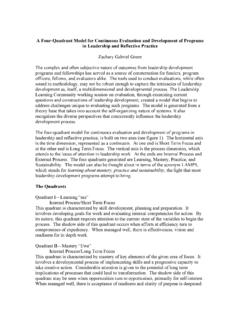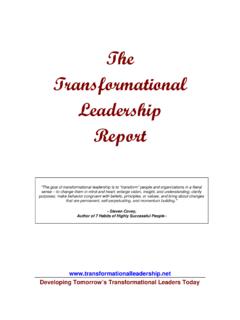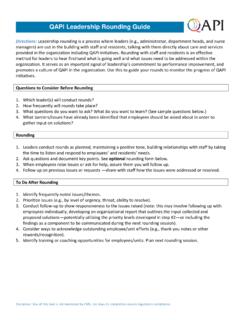Transcription of Leadership Development in the US- Best Practice-FINAL
1 Leadership Development in the : Principles and Patterns of Best Practice This paper creates a platform for discussion and learning. The views and opinions presented by the author are not necessarily shared by Bertelsmann Stiftung. 2 Authors: For more information about the initiative: Grady McGonagill Tina Doerffer With Peter W. Pruyn McGonagill Associates Bertelsmann Stiftung Brookline, MA, G tersloh, Germany 3 Table of Contents TABLE OF CONTENTS .. 2 EXECUTIVE SUMMARY .. 4 1. THE NATURE OF THE STUDY .. 9 Study Purpose and Scope .. 9 Methodological Assumptions and Limits .. 9 2. TRENDS AFFECTING Leadership .. 13 Societal Trends .. 13 Trends in Understanding How Adults Learn and 14 Trends in Understanding/Definition of Leadership .. 14 3. BEST PRACTICE: PRINCIPLES AND PRACTICES .. 18 Programs Supporting Individual Leader Development .. 18 Programs Supporting Collective Leadership Development .
2 53 Noteworthy Theories, Tools, and Practices .. 59 The Potential of the World Wide Web for Leadership Development .. 74 Sector-Specific Patterns in Leadership Development .. 103 4. IMPLICATIONS OF THE STUDY FOR FOUNDATIONS CONSIDERING SPONSORSHIP OF Leadership Development .. 116 The Value of Investing in Leadership Development .. 116 Strategies for Investing in Leadership Development .. 117 The Value of Building a Leadership Development 121 INDEX OF ORGANIZATIONS AND PROGRAMS .. 126 REFERENCES .. 134 END NOTES .. 144 4 Executive Summary This study aims to identify best practices in Leadership Development in the as part of a larger initiative to enhance the quality of Leadership in the public sector and civil society in Germany. For the most part it reflects analysis of patterns in existing cases and other studies rather than compilation of new information. At the same time, by looking systematically at Leadership Development practices in all sectors, it offers what the authors believe to be a unique contribution.
3 Background trends Leadership Development has undergone tremendous evolution in recent decades. It is now at a stage of acute fermentation, stimulated by the intersection of a number of trends: In society, where: Increasingly complex, global challenges require new levels of capacity and consciousness from leaders Technology provides new resources for learning Networks and multi-stakeholder partnerships offer new resources for change In our understanding of adult Development , where we now: Draw upon new learning from neuroscience and psychology Realize the potential for adults to continue to evolve in consciousness Appreciate the challenge and support required for continued learning and Development In the evolution of Leadership theory, which increasingly: Places new emphasis on leading change Appreciates the contribution of collective wisdom and Leadership Offers potent new meta-theories and related practices Principles and Patterns of Best Practice The study strives to identify best practices while acknowledging the inherent limits of such an effort.
4 Leadership Development is an adaptive challenge to which there are no clearly defined solutions; evidence of impact for most programs is scant. Nonetheless, the best programs appear to be designed and implemented in accordance with nine general principles: 1. Reinforce/build a supportive culture 2. Ensure high-level sponsorship 5 3. Tailor the goals and approach of the program to the context 4. Target programs toward specific audiences 5. Integrate all features of the program 6. Use a variety of learning methods 7. Offer extended learning periods with sustained support 8. Encourage commitment to self- Development 9. Commit to continuous improvement Effective programs appear to have more to do with the quality of overall design, integration and implementation than with the choice of particular elements. However, the most effective programs draw on a small number of common practices that have been well documented. The study synthesizes existing research and analysis to offer profiles of seven of the most common practices for individual leader Development : 1.
5 Job definition/assignment 2. Action learning 3. Assessment/feedback 4. Formal instruction 5. Coaching 6. Mentoring 7. Networking We also identify effective approaches to collective Leadership Development : Within organizations Across organizations In particular communities Aiming for systemic change In addition, we briefly summarize a number of noteworthy theories, tools, and modules that are particularly powerful or promising. The theories include three meta-theories : Organizational learning Integral Leadership Theory U We also recommend a number of tools and modules at four levels: Intrapersonal Constructive developmental theory and assessment tools Mental models Immunity to change 6 Personal mastery Presencing Mindful awareness practices Authentic Leadership Embodied consciousness Personality style assessment Solo retreats in nature Interpersonal/Team Interpersonal skills Facilitation skills Dialogue Shared vision Organizational Systems thinking Storytelling Adaptive Leadership Rapid-cycle prototyping Transorganizational/Systemic Convening Learning journeys Communities of practice Communities of place Multi-stakeholder partnerships Social networking technology As part of our review of tools, we take a special look at the powerful implications of web-based technologies for Leadership Development , reviewing.
6 The features of Web , , and The implications of these tools for organizations in the three primary sectors Their implications for Leadership and Leadership Development We discovered common features across all sectors regarding both the challenges of Leadership Development and the responses that constitute best practice. However, we found striking differences as well, reflecting differing patterns by sector of challenge and constraint: The private sector driven by competition and supported by clear performance metrics invests the most resources and has generated the most documentation. This sector most 7 fully illustrates the value of Leadership Development and the variety of approaches possible, although programs are typically limited to the Development of individual leaders. The public sector which faces more ambiguous challenges and operates with greater constraints invests less in Leadership Development and has generated fewer visible examples of best practice.
7 However, the military offers some of the best examples of best practice in any sector. The non-profit sector where foundations have learned the importance of Leadership Development as a means to organizational effectiveness has begun to invest heavily in Leadership Development and is sponsoring a wide range of creative approaches, along with thoughtful documentation and research. This sector illustrates a clear trend toward network- rather than organization-centric Leadership and toward collective Leadership Development . Multi-sector/multi-stakeholder programs which deliberately recruit individuals from all parts and levels of the system have recently evolved to address the increasingly complex adaptive societal challenges that transcend any single sector and that require broad participation to be fully understood and effectively engaged. Implications for Foundations In conclusion we affirm the value of investing in Leadership Development , which has been demonstrated in all sectors.
8 For example, it can: Attract, retain, and develop the best talent Build a culture supportive of the organization s mission Create an institutional competitive advantage Foster networks across organizations to address complex, multi-sectoral problems Develop the mindsets, skills, and communities of practice to bring about systemic change We review the strategies that foundations could use to this end in their internal practices. And we identify the most common funding strategies that have been employed by foundations, providing a number of specific illustrations: Support Leadership Development Within organizations In communities In specific sectors or fields of practice As a means of addressing specific problems Build system-wide capacity for Leadership 8 Support applications of evolving web-based technologies to enhance the effectiveness of organization- and network-centric programs As this list illustrates, there is enormous variety in the ways in which a foundation can approach Leadership Development .
9 How can a foundation staff go about choosing among them? We recommend that any foundation considering investing in this area develop a Leadership Development Model to guide its design of an initiative. As a tool for model building we offer a Leadership Strategy Option Matrix that we adapted from the most outstanding studies of best practice. The 5x5 matrix provides a systematic way of choosing from among a broad range of strategies, including systemic initiatives that foundations are uniquely well positioned to undertake. Such a model can continue to evolve through participation in a community of practice on Leadership Development . In conclusion, we offer the judgment that foundations can exercise the highest leverage by fostering the Development of and participating in eco-systems to support Leadership Development . They are uniquely positioned to do so and can, in our view, make an enormous social contribution.
10 9 1. The Nature of the Study Study Purpose and Scope The Charge This study is one component of a larger project by the Bertelsmann Stiftung on Leadership Education. Our original charge was to identify best practices in Leadership Development , with the aim of contributing to the design of curricula for a potentially wide range of audiences in the public and non-profit sectors in Germany. The project has input from several other studies: on the theory of Leadership in Germany and the , on Leadership Development programs in Germany and selected European programs, and on program evaluation. The curricula will be developed with the help of a consulting team. The Scope Although the ultimate purpose is to support Leadership Development in the public and non-profit sectors, the study aims to draw upon best practice not only in these domains but in the corporate world as well. We were asked to focus principally on the as a source of innovation from a long-established field of practice.










